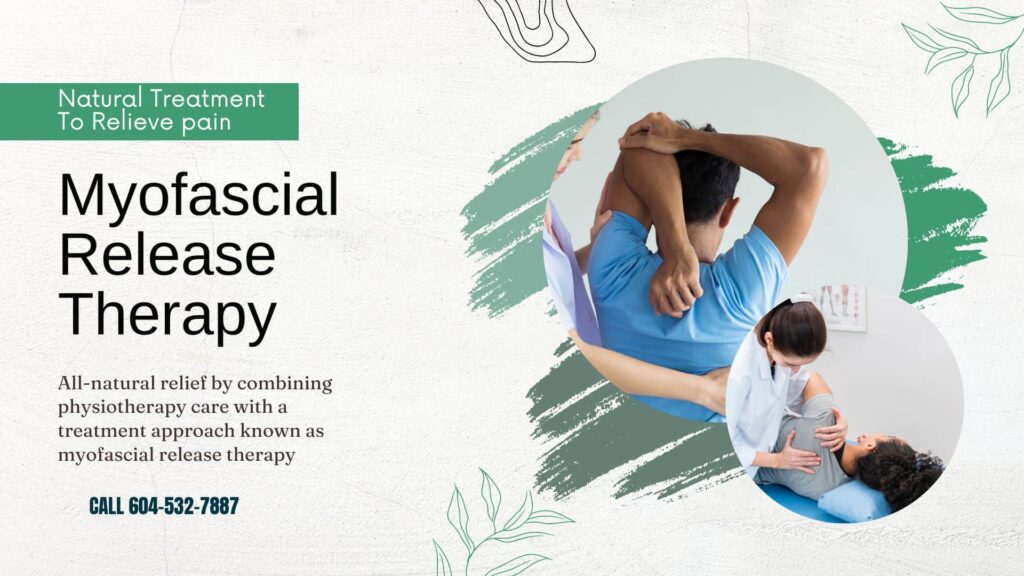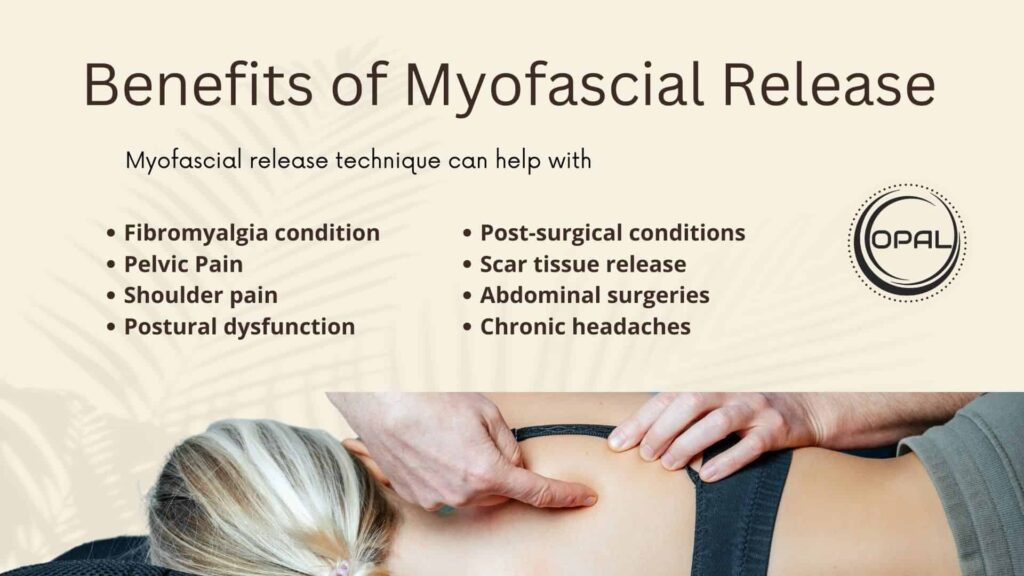Myofascial Release Therapy in Langley
Do you suffer from chronic pain and stiffness?
Myofascial pain syndrome is a condition that you may have. Myofascial Pain syndrome is a disorder that can cause persistent pain and other unpleasant sensations throughout your body due to restriction in muscle movement and range of motion.
Myofascial release is a manual therapy technique used to treat soft tissue injuries and pain in the body. The focus is on releasing muscular tension and restoring range of motion which can help to reduce pain, improve flexibility, and promote healing in affected areas.
At Opal Physio the physiotherapists use their hands or therapeutic tools to provide myofascial release and will be using it in combination with other treatments such as stretching and strengthening exercise to improve normal function.

Myofascial Release
A myofascial release is a form of physical therapy treatment that focuses on the fascia, the connective tissue covering the muscle. This manual therapeutic approach can help with long-term relief from pain and enhance soft tissue function.
The myofascial release technique is a hands-on therapy in which a therapist uses gentle, sustained pressure to release muscle and connective tissue tension. This therapy is usually performed by a physical therapist or other healthcare professionals like RMTs.
Myofascial release therapy aims to treat chronic pain disorder from muscle tightness, decrease recovery time from injury, and increase the range of movement for people with joint or muscle stiffness.
At Opal Physiotherapy, we use myofascial release techniques to help improve the muscle and joint range of motion and reduce scar tissue.
Fascia and Its Function
A fascia is a thin, fibrous connective tissue that covers, binds together, and separates the muscles. Fascia is also known as “the body’s sheath of tissue.” Fascia can be found throughout the body, and the connective tissue structure surrounds muscle groups, the brain, the spinal cord, bones, lymph nodes, organs, blood vessels, arteries, and nerves. It holds certain parts together while allowing others to move freely. Fascia is made of collagen fibres that provide strength to these structures.
Myofascial Trigger points
Myofascial trigger points are localized pain or tenderness in areas of the body where muscles and other soft tissues can become tight and can become inflamed. Myofascial trigger points are painful knots that are sensitive to touch and caused by tight, overactive muscles. This can develop from repetitive physical activity or repetitive use of a single muscle.
Myofascial trigger points can often be identified by these two characteristics: Painful to touch – The pain you feel when you press on the trigger point. Tightness – The muscle next to the trigger point is tight and hard to move.
This type of pain is typically caused by repetitive strain, injury, or overuse and is more common in the lower back, gluteal, neck, shoulder and scapular region.
Trigger Point Release
The trigger point release is a type of deep tissue muscle release that aims to release tension in tight muscles. In this treatment, the therapist provides specific trigger point release on the patient’s myofascial connective tissues that surround and support muscles to provide length to the muscles. When these trigger points are released, they can help with pain reduction and improve flexibility.
Myofascial Pain Syndrome
Myofascial pain syndrome(MPS) is a chronic, localized pain caused by myofascial trigger points in the soft tissue, muscles and connective tissues. The word “myofascial” refers to the fascia, a tough, elastic tissue that surrounds and insulates muscles. The word “trigger points” means that a cluster of nerve endings in the fascia becomes sensitive and sends pain signals to other body parts when compressed.
Issues in this connective tissue system can be due to aging, repetitive strain injuries, and incorrect postures. Any part of the body might develop myofascial tightness or limitations. It is unique compared to other types of pain because it is more localized to where your myofascial tissue intersects.
Causes of myofascial pain syndrome
The cause of myofascial pain syndrome is not known. However, it is said to be related to a trigger point in a muscle from overuse and repetitive injury and muscle weakness. The trigger point develops when there is an accumulation of lactic acid in the muscle, which causes inflammation and soreness. Trigger points may also be caused by stress or emotional factors such as anger, fear or depression.
Myofascial pain syndrome is often treated by physical therapy or medications. Contact us today if you are experiencing myofascial pain.
Symptoms of Myofascial Pain
Myofascia pain can be both temporary and permanent and can also range from mild to severe.
The most common myofascial pain symptoms can include the following:
- Dull, aching pain that is difficult to pinpoint.
- Pain in one or more areas of your body, including your neck, shoulders, back or hips.
- Pain that worsens after you have been inactive for a period of time.
- Pain is characterized by deep aches, pulsating, and tightness in the muscles or connective tissue.
- Restricted range of motion in the affected muscle area.
- Other symptoms include fatigue and insomnia.
Causes of Myofascial Restrictions.
1. Inflammation
Any prolonged inflammation might alter the muscle’s behaviour and can cause limitations in muscles and joints, causing pain.
2. Trauma to the muscle tissues or fascia
When a muscle is injured, the surrounding tissue can become tight and constrict the muscle, leading to a myofascial restriction. Tissue can alter as a result of injuries after a trauma or procedures following surgery. Scar tissue forms when your body attempts to repair the injury or wound, causing fascial restrictions.
3. Lack of movement
Blood flow is restricted when myofascial tissue is compressed for too long. Blood flow is essential for the health of fascia and muscle tissue. Sustained prolonged tasks like sitting for a longer duration can cause fascial restrictions from reduced blood flow.
4. Repetitive movements
Repetitive motions from overuse can lead to tightness in the muscles, which can eventually lead to myofascial restrictions and pain.
5. Emotional stress
Emotional stress can cause the body to tense up, which can, in turn, lead to myofascial restrictions.
6. Poor posture
It is no secret that poor posture can lead to a host of problems, including myofascial restrictions. When the muscles and fascia become restricted, it can lead to pain, decreased range of motion, and other issues. Poor posture can also cause nerve compression or irritation, which can further contribute to pain.
7. Muscle imbalances
Muscle imbalances such as weakness or tightness in one muscle group can lead to other muscles compensating for it, leading to myofascial restrictions.

When to use myofascial release techniques?
The myofascial release technique is an effective treatment for a wide variety of disorders, as it provides pain relief while also improving myofascial mobility. These are some of the most common conditions:
- Chronic neck pain
- Chronic back pain
- Shoulder pain
- The scapula or shoulder restrictions
- Whiplash associated disorders
- Chronic headaches
- Hip Stiffness
- Fibromyalgia condition
- Menstrual pain
- Pelvic Pain
- Acute strains
- Knee pain
- Hand pain
- Postural dysfunction
- Post-surgical conditions
- Scar tissue release
- Plantar fasciitis
- Abdominal surgeries
Self-Myofascial Release
Self-myofascial release (SMR) is a type of self-massage that is used to release tightness in the muscles and connective tissue. This type of massage can be done by yourself with a foam roller, roller massager, or a tennis ball. SMR is said to improve range of motion, decrease pain, and improve recovery time from workouts.
Myofascial release vs. massage therapy
There are a few key differences between myofascial release and massage therapy. First, myofascial release focuses on releasing the fascia, or connective tissue, that surrounds the muscles. This can help to improve the range of motion and flexibility.
Massage therapy, on the other hand, focuses on the muscles themselves. This can help to improve circulation, reduce pain, and muscle tension, reduce stress and promote general health.
Another key difference is that myofascial release is typically done using light to moderate pressure, while massage therapy can be done using a variety of pressures depending on the client’s needs.
Myofascial Release Advantages
Some of the advantages of myofascial release are:
- Myofascial release is a non-invasive treatment for releasing tight muscles.
- It is a relatively inexpensive treatment.
- It reduces the need for medication.
- It does not have any side effects.
- It can be done anywhere if someone has the necessary equipment and knowledge.

Benefits of Combining Physiotherapy Care With Myofascial Release Therapy
Myofascial release is used by physiotherapists as part of their treatment for patients with muscular-skeletal pain.
Physiotherapists are trained to perform manual therapy treatments such as joint mobilization and soft tissue massage on your muscles, tendons and ligaments to improve blood circulation and relieve muscle tension which helps reduce inflammation associated with chronic injury or disease processes. This treatment is often combined with other effective conservative approaches, such as exercise therapy, to maximize your recovery potential.
When you combine the two treatments, you get a treatment plan that addresses the specific area where you’re experiencing pain and your overall healing process.
- It allows the connective tissue to stretch and lengthen, which may decrease pain and improve movement.
- Improved flexibility in your muscles and joints
- Reduced swelling in your joints and surrounding tissues
- Increased range of motion within your joints
- help alleviate pain symptoms
Myofascial release as part of physiotherapy treatment works together to give long-term relief. Our physiotherapists help with mobility and provide exercises to improve alignment that can reduce the risk of myofascial stiffness and discomfort. Additionally, myofascial release with exercise sessions helps protect your tissues from stiffening up and helps with your flexibility.
Other alignment abnormalities, muscular trigger sites, and muscle strength and length imbalances must also be addressed concurrently with myofascial release.
Our physiotherapist will also show you how to use self-management techniques to self-administer simple types of myofascial release to keep your tissues flexible. The home management approach allows you to keep the flexibility, range, and posture achieved during the treatment session to ensure that you get the most out of your therapy.
Schedule an appointment for myofascial release in Langley
At Opal Physio, our experienced physiotherapists use myofascial release trigger point therapy as one of the numerous treatment choice combinations accessible to our patients. Contact us for more information about our myofascial release.
Ready to schedule an appointment? You can give us a call at (604) 532-7887 or fill out our contact form online.
